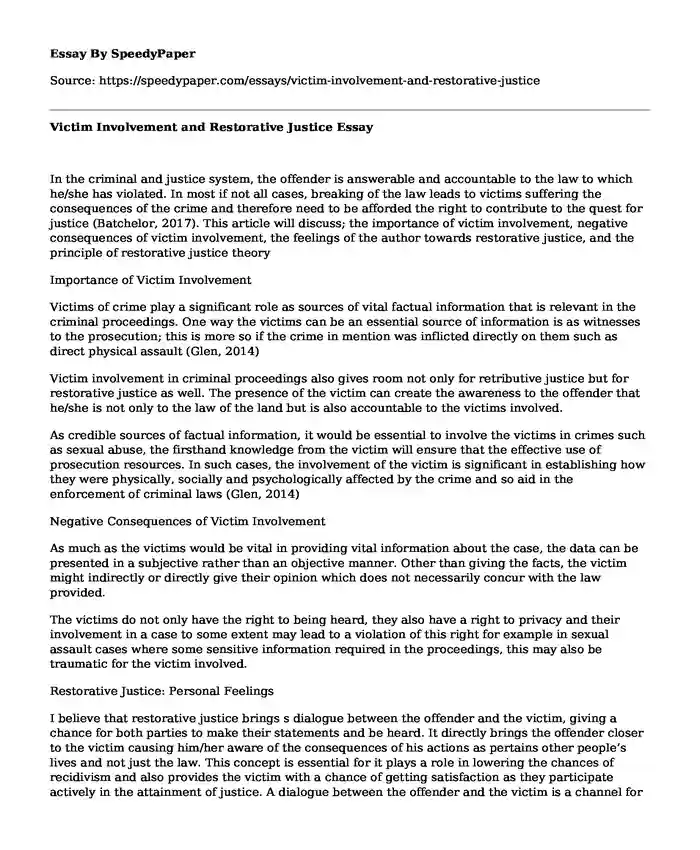
| Type of paper: | Research paper |
| Categories: | Company Culture Economics Literature Analysis |
| Pages: | 3 |
| Wordcount: | 723 words |
In the criminal and justice system, the offender is answerable and accountable to the law to which he/she has violated. In most if not all cases, breaking of the law leads to victims suffering the consequences of the crime and therefore need to be afforded the right to contribute to the quest for justice (Batchelor, 2017). This article will discuss; the importance of victim involvement, negative consequences of victim involvement, the feelings of the author towards restorative justice, and the principle of restorative justice theory
Importance of Victim Involvement
Victims of crime play a significant role as sources of vital factual information that is relevant in the criminal proceedings. One way the victims can be an essential source of information is as witnesses to the prosecution; this is more so if the crime in mention was inflicted directly on them such as direct physical assault (Glen, 2014)
Victim involvement in criminal proceedings also gives room not only for retributive justice but for restorative justice as well. The presence of the victim can create the awareness to the offender that he/she is not only to the law of the land but is also accountable to the victims involved.
As credible sources of factual information, it would be essential to involve the victims in crimes such as sexual abuse, the firsthand knowledge from the victim will ensure that the effective use of prosecution resources. In such cases, the involvement of the victim is significant in establishing how they were physically, socially and psychologically affected by the crime and so aid in the enforcement of criminal laws (Glen, 2014)
Negative Consequences of Victim Involvement
As much as the victims would be vital in providing vital information about the case, the data can be presented in a subjective rather than an objective manner. Other than giving the facts, the victim might indirectly or directly give their opinion which does not necessarily concur with the law provided.
The victims do not only have the right to being heard, they also have a right to privacy and their involvement in a case to some extent may lead to a violation of this right for example in sexual assault cases where some sensitive information required in the proceedings, this may also be traumatic for the victim involved.
Restorative Justice: Personal Feelings
I believe that restorative justice brings s dialogue between the offender and the victim, giving a chance for both parties to make their statements and be heard. It directly brings the offender closer to the victim causing him/her aware of the consequences of his actions as pertains other people's lives and not just the law. This concept is essential for it plays a role in lowering the chances of recidivism and also provides the victim with a chance of getting satisfaction as they participate actively in the attainment of justice. A dialogue between the offender and the victim is a channel for restoring harmony between the two parties and is a chance to heal the injured relationships and so should be fostered by the justice system as a means of bettering the community at large.
Restorative Justice Theory
Restorative justice theory states that crime causes harm; hence justice should be focused on repairing that harm. Restorative justice seeks to provide a reconciliation between the offender and the victim where possible, especially in cases where the offender is willing to accept and take responsibility for their offense (Gordon, Lori & Green, 2007). Restorative justice is justice that is victim based per se, and the victims get more satisfaction as they contribute fully to what the measures they require taken in light of the offense committed. The chance for dialogue ensures that both parties can continue to live in harmony even after proceedings and hence can be an alternative to retributive justice.
References
Batchelor, D. (2017). Restoring choice: The Relationship between Offense Seriousness, Intervening Time, and And Victims' Responses to the Offer of Restorative Interventions. Victims & Offenders, 12(2), 205-232. Retrieved from; https://www.tandfonline.com/doi/abs/10.1080/15564886.2014.1000557
Glen A. Ishoy (2014) Reassessing the Purpose of Punishment: The Roles of Mercy and Victim-involvement in Criminal Proceedings, Criminal Justice Ethics, 33:1, 40-57, DOI: 10.1080/0731129X.2014.903631
Gordon B, Lori E & Green D. (2007) The "Independent Variable" in Restorative Justice: Theory-Based Standards for Evaluating the Impact and Integrity of Victim Sensitive Process (Part II), Victims & Offenders, 2:4, 351-373, Retried from https://www.tandfonline.com/doi/abs/10.1080/15564880701404056
Cite this page
Victim Involvement and Restorative Justice. (2022, Dec 23). Retrieved from https://speedypaper.com/essays/victim-involvement-and-restorative-justice
Request Removal
If you are the original author of this essay and no longer wish to have it published on the SpeedyPaper website, please click below to request its removal:
- Metaethics - Free Essay in Philosophy
- Freedom of Speech Limits - Argumentative Essay Example
- Free Essay: Slavery Leading Up to The Civil War
- Free Essay Sample on Pope Urban's Speech at Clermont
- Ethics Case Study Scenarios Post-Partum Depression and Risk
- Ozone Depletion, Free Essay Sample
- Chemistry Essay Example on Acids, Bases, and Salts
Popular categories




